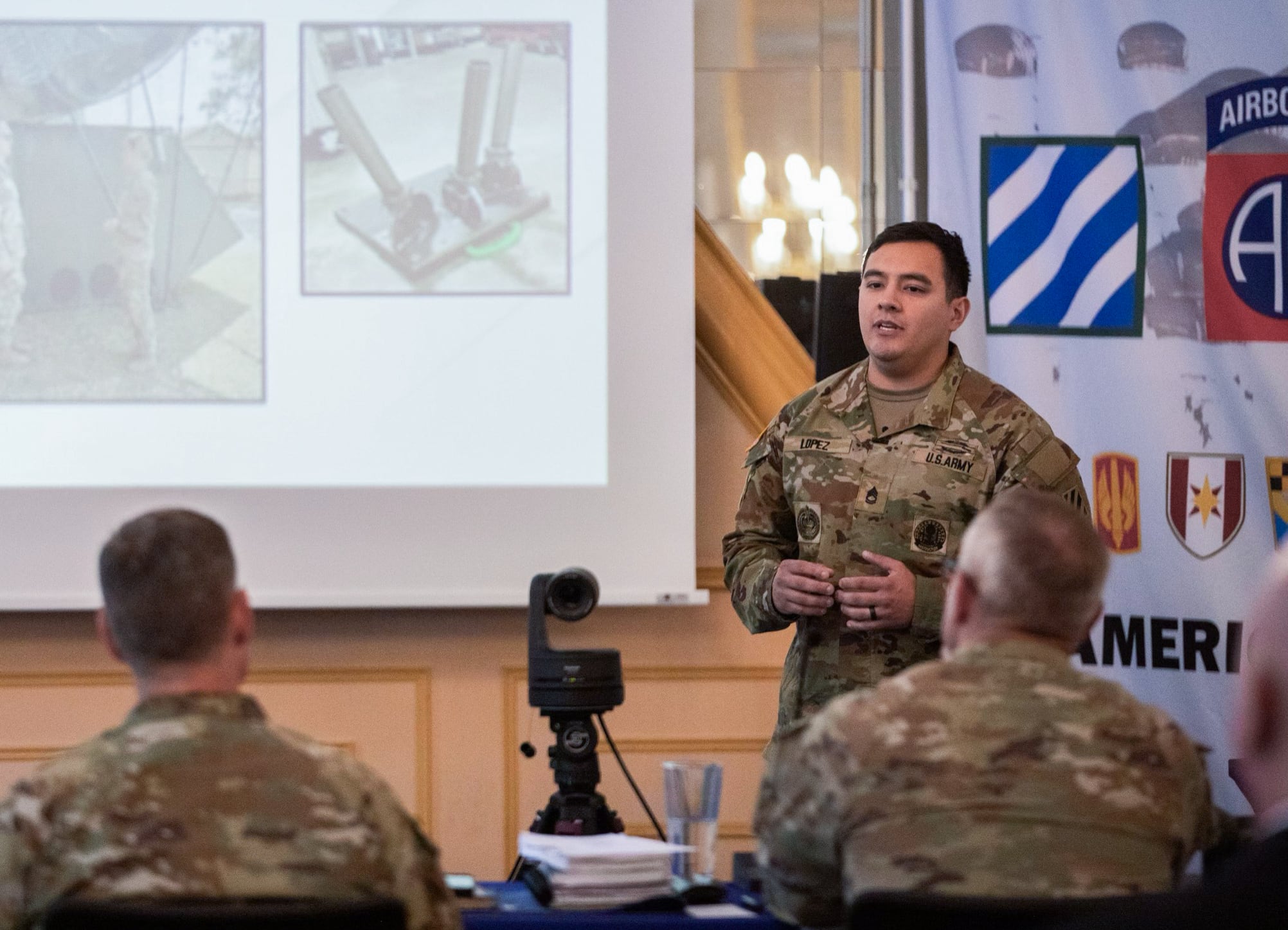Despite the pricey, high-tech advances of today’s Army, an old-school field task — assembling camouflage netting and poles to hide vehicles — remains part of the drudgery of a soldier’s life.
But a new invention that can be built with parts from a hardware store makes the task easier, faster and mobile, saving soldiers time and energy when they need it most.
The Vehicle-Integrated Camouflage System was invented by Sgt. 1st Class Nathan Lopez, a former sniper and the non-commissioned officer-in-charge at the Marne Innovation Center at Fort Stewart, Georgia.
The system allows two soldiers to conceal a large combat vehicle in less than 15 minutes, a job that traditionally required four well-practiced soldiers and 30 minutes of work.
It consists of five pieces of metal welded together to form a bolt-on bracket that attaches to existing holes in an Army vehicle. The bracket features a cylindrical device used as an insert to attach camo netting poles for better concealment.
Currently, most camo nets are set up by stretching the netting with a series of poles placed at angles around the vehicle and into the ground, much like tent stakes.
RELATED
That means that every time soldiers set it up, they must tear all the equipment down and pack it up to move the vehicle and then set it up again.
But with this device, the netting can remain on the vehicle if it must be moved, further saving time and energy.
It’s a solution that directly impacts how soldiers do their jobs, and Lopez said he suspects that more such innovations are waiting in the ranks.
“Soldiers across the formation are currently developing answers, it’s just a matter of how we tap into that,” Lopez told Army Times.
For his and his team’s efforts, Lopez won the annual XVIII Airborne Corp’s Dragon’s Lair innovation competition earlier this month.
The Dragon’s Lair event is a “Shark Tank” style competition where participants pitch their problem-solving ideas to a board of military and science experts who then select the best submission. For winning the competition, Lopez received a Meritorious Service Medal and will attend an Army training school of his choosing. In Lopez’s case, he chose Survival, Evasion, Resistance and Escape, or SERE, training.
Past winners have included a 3D-printed device that uses sensors to detect mold conditions and can share its data in real time, and a helicopter pilot flight training tool that gives students immediate performance feedback.

Other offerings in this year’s competition included a software application to record and process meetings, a machine-learning tool that uses databases and dashboards to conduct risk assessments and an automated ammunition request builder for platoon and company leaders, according to the Army.
Lopez won the 10th iteration of the competition, held this year in Stuttgart, Germany, with his Vehicle-Integrated Camouflage System.
Concealing Army vehicles was prevalent during the Cold War, when the U.S. military trained to prepare for a war with the Soviet Union.
But during the wars in Iraq and Afghanistan, such concealment was not required.
Today, as the U.S. military prepares for war with China or another conventional adversary, the Army is once again preaching the gospel of concealment and moving on a battlefield where they will need to regularly cloak their gear.
The explosion of drone warfare in Ukraine has further reinforced the need for troops to be able to conceal their vehicles fast.
Lopez’s team chose the Armored Multi-Purpose Vehicle as their platform, in part because it was one of the more difficult vehicles to conceal, he said.
After some refinements, Lopez represented his team at unit-level competitions to ultimately compete in the Dragon’s Lair, which includes all the subordinate units of the XVIII Airborne Corps.
“Presenting was not as nerve-wracking as I thought it would be,” Lopez said.
The next steps will likely involve sharing the device with the Army’s Combat Capabilities Development Command, which oversees much of the service’s technology adoption, Lopez said.
If the device can pass the necessary tests and be fitted to multiple types of vehicles, there’s potential for it to be distributed across the Army.
The war in Ukraine has showcased the need for fast innovation, something that by its nature comes from the rank-and-file, XVIII Airborne Corps deputy commanding general Brig. Gen. John Cogbill said in a statement.
“Innovation is too important to be left to generals and sergeants major,” he said. “I think the best ideas come from the bottom. They’re the people closest to the problems.”
Todd South has written about crime, courts, government and the military for multiple publications since 2004 and was named a 2014 Pulitzer finalist for a co-written project on witness intimidation. Todd is a Marine veteran of the Iraq War.
Read the full article here
